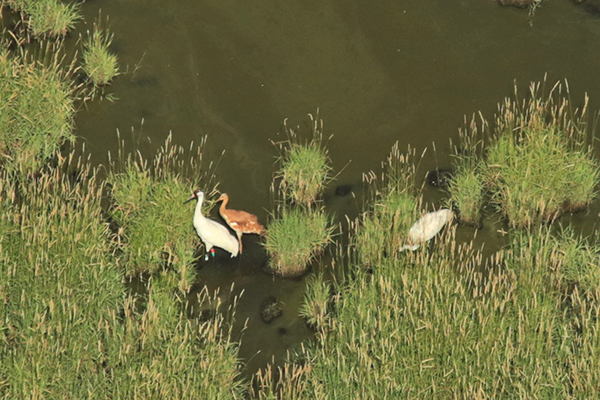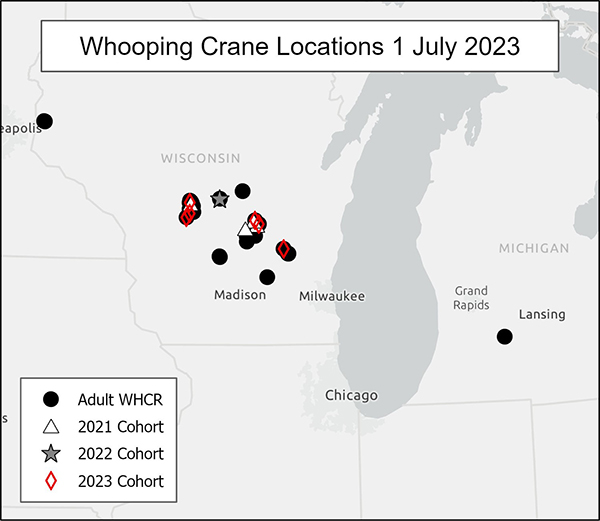
Below is the most recent update for the Eastern Migratory Population of Whooping Cranes. All nests have been completed in June, and the chicks are doing well! A huge thank you to the staff of the Fish and Wildlife Service, the Departments of Natural Resources of flyway states, the International Crane Foundation, and all the volunteers who help us keep track of the cranes throughout the year. We appreciate your contribution to the recovery of the Whooping Crane Eastern Migratory Population. The International Crane Foundation produced this report.
Population Estimate
The current estimated population size is 70 (36 F, 33 M, 1 U). Fifteen of these 70 individuals are wild-hatched, and the rest are captive-reared. This does not yet include 2023 wild-hatched chicks. To the best of our knowledge, as of 1 July, there are at least 58 in Wisconsin and one in Michigan. The remaining birds’ locations have not been confirmed in the last month. Their last known locations in the past month are on the map below.

2021 and 2022 Cohorts
W2-21 (M) is still in Green Lake County, Wisconsin, with W3-17.
W14-21 (M) finally showed up at Necedah National Wildlife Refuge.
84-21 (F) and 85-21 (M) are still together in Green Lake County, Wisconsin.
W1-22 (U) is still in Adams County, sometimes with W3-20 (F).
Reproduction
There were 22 pairs and 25 nests (22 first nests, 3 renests). Thirteen nests hatched and produced at least 14 chicks, 7 of which are still alive. There are currently no active nests.
Nests that were completed by 1 July:
One failed (predation), 4 hatched (2 first nests, 2 renests), and 2 had unknown outcomes but were incubated full term. All nests were in Juneau County.
Wild-hatched chicks (chicks listed in bold are currently alive):
W1-23 hatched to parents 10-15 and 4-13 in Green Lake County in early May and is still with their parents.
W2-23 hatched to parents 38-17 and 63-15 in Dodge County in early May and is still with their parents.
W3-23 hatched to parents 1-17 and W1-19 in Portage County in early May and is still with their parents.
W4-23 hatched to parents 24-17 and 4-17 in Sauk County in mid-May but disappeared in late June.
W5-23 and W6-23 hatched to parents 4-12 and 3-14 in Green Lake County in mid-May. W6-23 disappeared during May, but W5-23 is still with their parents.
W7-23hatched to parents 1-11 and 59-13 in St. Croix County in late May but disappeared mid-June.
W8-23hatched to parents 79-19 and W13-20 in Dodge County in late May but disappeared during early June.
W9-23 hatched to parents 15-11 and 29-08 in Juneau County in late May and is still with their parents.
W10-23hatched to parents W1-18 and W6-18 in Juneau County in late May but disappeared during mid-June.
W11-23hatched to parents W1-06 and W10-15 in Juneau County but unfortunately did not live very long.
W12-23 hatched to parents 24-08 and 13-02 in Juneau County during early June and is still with their parents.
W13-23 hatched to parents 12-11 and 5-11 in Juneau County during early June and is still with their parents.
W14-23hatched to parents 42-09 and 37-07 in Juneau County during early June but disappeared mid-June.
Mortality and Long-term Missing
None known.

Story submitted by Hillary Thompson, North America Program Crane Analyst. Click here to learn more about our work in North America.
